+48
UZB-76
Hole
Mig-31BM2 Super Irbis-E
Tsavo Lion
PeeD
ATLASCUB
Isos
crod
starman
nomadski
miketheterrible
Visc
yavar
rambo54
KiloGolf
airstrike
MTN1917
d_taddei2
JohninMK
Stealthflanker
flamming_python
max steel
ShahryarHedayatiSHBA
sepheronx
magnumcromagnon
nemrod
Werewolf
Mike E
AlfaT8
dino00
sheytanelkebir
mack8
medo
TheArmenian
TR1
George1
Cyberspec
Mindstorm
GarryB
SOC
Viktor
Austin
lulldapull
ahmedfire
IronsightSniper
Kysusha
Admin
nightcrawler
52 posters
Iran Air Defense Systems

Hole- Posts : 10982
Points : 10962
Join date : 2018-03-24
Age : 48
Location : Scholzistan
- Post n°301
 Re: Iran Air Defense Systems
Re: Iran Air Defense Systems
medo and UZB-76 like this post

UZB-76- Posts : 24
Points : 24
Join date : 2020-09-13
- Post n°302
 Re: Iran Air Defense Systems
Re: Iran Air Defense Systems
That is Bavar-373
kvs likes this post

George1- Posts : 18400
Points : 18897
Join date : 2011-12-22
Location : Greece
- Post n°303
 Re: Iran Air Defense Systems
Re: Iran Air Defense Systems
GarryB, medo and PapaDragon like this post

Kiko- Posts : 3203
Points : 3261
Join date : 2020-11-11
Age : 75
Location : Brasilia
- Post n°304
 Re: Iran Air Defense Systems
Re: Iran Air Defense Systems
Iran Boasts Newest Version of Bavar-373 Air Defense System is Better Than Russia’s S-400, by Morgan Artyukhina for Sputniknews. 23/08/2021.
In 2019, Iranian Brig. Gen. Shahrokh Shahram, then head of the defense ministry’s Organisation of Electronic Industries, said the Bavar-373 exceeded the capabilities of the US’ Patriot air defense system and even the Terminal High Altitude Area Defense (THAAD), although he was nonspecific as to which version of the Patriot its performance exceeded.
Iran’s newest version of the Bavar-373 is an even more effective air defense system than the Russian-made S-400 Triumf system, according to an Iranian defense leader.
“New editions of the Bavar-373 are coming and soon, a new edition that may be at the same or higher level than S400 will be unveiled,” Iranian Deputy Defense Minister Brig. Gen. Mahdi Farahi said during a Sunday television interview.
According to Iran’s Tasnim News Agency, the former Aerospace Industries Organization chief also said that the country had developed a new type of liquid rocket fuel that’s as stable as solid fuel. Typically, solid fuels are placed in rockets that must be ready to fire at a moment’s notice, but with the disadvantage that the fuel is less efficient than liquid fuel. Stable liquid fuel would give Iranian missiles a faster firing time and speed while making them lighter at the same time.
The Bavar-373 was Iran’s answer to an export ban by Russia on its S-300 surface-to-air missile system until 2015. The domestically developed system employs multiple radars for detecting up to 300 targets at a time, tracking 60 of them, and engaging six, and can punch through many types of jamming.
Ironically, the Bavar-373’s projectile, the Sayyad-4 missile, is an improved version of a reverse-engineered Standard Missile-1 (SM-1) sold to Iran by the United States prior to the 1979 Islamic Revolution that threw out the Western-backed shah and ushered the present government into power. It has a range of up to 210 kilometers and can approach hypersonic speeds.
That will have to be considerably improved upon if the new version is to outperform the S-400, which can hit targets some 400 kilometers out when using the ultra-long-range 40N6E missiles. However, if it can indeed do so, then Iran could have a viable weapon for shooting down low-altitude satellites, or ballistic missiles in their midcourse phase.
In June, Dmitry Shugaev, the director of the Russian Federal Service for Military-Technical Cooperation, said that Tehran was interested in several Russian-made weapons systems, with Iran’s then defense minister, Brig. Gen. Amir Hatami, having inspected an S-400 at the ARMY-2020 military expo outside Moscow the previous August.
Since October 2020, international sanctions against Iran that blocked it from buying weapons abroad expired, but if Tehran were to buy S-400s from Russia, it would open them up to new sanctions from the US under the Countering America's Adversaries Through Sanctions Act (CAATSA). India, China, and Turkey have had to wrestle with similar restrictions when buying S-400s.
https://sputniknews.com/military/202108231083695915-iran-boasts-newest-version-of-bavar-373-air-defense-system-is-better-than-russias-s-400/
In 2019, Iranian Brig. Gen. Shahrokh Shahram, then head of the defense ministry’s Organisation of Electronic Industries, said the Bavar-373 exceeded the capabilities of the US’ Patriot air defense system and even the Terminal High Altitude Area Defense (THAAD), although he was nonspecific as to which version of the Patriot its performance exceeded.
Iran’s newest version of the Bavar-373 is an even more effective air defense system than the Russian-made S-400 Triumf system, according to an Iranian defense leader.
“New editions of the Bavar-373 are coming and soon, a new edition that may be at the same or higher level than S400 will be unveiled,” Iranian Deputy Defense Minister Brig. Gen. Mahdi Farahi said during a Sunday television interview.
According to Iran’s Tasnim News Agency, the former Aerospace Industries Organization chief also said that the country had developed a new type of liquid rocket fuel that’s as stable as solid fuel. Typically, solid fuels are placed in rockets that must be ready to fire at a moment’s notice, but with the disadvantage that the fuel is less efficient than liquid fuel. Stable liquid fuel would give Iranian missiles a faster firing time and speed while making them lighter at the same time.
The Bavar-373 was Iran’s answer to an export ban by Russia on its S-300 surface-to-air missile system until 2015. The domestically developed system employs multiple radars for detecting up to 300 targets at a time, tracking 60 of them, and engaging six, and can punch through many types of jamming.
Ironically, the Bavar-373’s projectile, the Sayyad-4 missile, is an improved version of a reverse-engineered Standard Missile-1 (SM-1) sold to Iran by the United States prior to the 1979 Islamic Revolution that threw out the Western-backed shah and ushered the present government into power. It has a range of up to 210 kilometers and can approach hypersonic speeds.
That will have to be considerably improved upon if the new version is to outperform the S-400, which can hit targets some 400 kilometers out when using the ultra-long-range 40N6E missiles. However, if it can indeed do so, then Iran could have a viable weapon for shooting down low-altitude satellites, or ballistic missiles in their midcourse phase.
In June, Dmitry Shugaev, the director of the Russian Federal Service for Military-Technical Cooperation, said that Tehran was interested in several Russian-made weapons systems, with Iran’s then defense minister, Brig. Gen. Amir Hatami, having inspected an S-400 at the ARMY-2020 military expo outside Moscow the previous August.
Since October 2020, international sanctions against Iran that blocked it from buying weapons abroad expired, but if Tehran were to buy S-400s from Russia, it would open them up to new sanctions from the US under the Countering America's Adversaries Through Sanctions Act (CAATSA). India, China, and Turkey have had to wrestle with similar restrictions when buying S-400s.
https://sputniknews.com/military/202108231083695915-iran-boasts-newest-version-of-bavar-373-air-defense-system-is-better-than-russias-s-400/

x_54_u43- Posts : 336
Points : 348
Join date : 2015-09-19
- Post n°305
 Re: Iran Air Defense Systems
Re: Iran Air Defense Systems
Iranian delusions part 32

GarryB- Posts : 39673
Points : 40169
Join date : 2010-03-30
Location : New Zealand
- Post n°306
 Re: Iran Air Defense Systems
Re: Iran Air Defense Systems
So they have upgraded an SM-2 missile and think it is better than an S-400 missile... which they don't have.
The SM-2 missile is a two stage missile and its performance is not bad... the US Navy of all the US services took SAM air defence the most seriously, though their choices are interesting to say the least... they didn't use a sea launched AMRAAM... their ESSM is a digital upgraded Sparrow AAM, and their SEA RAM is a combination of Sidewinder Stinger and Hellfire missiles...
I honestly wish them well and all the best with this new missile... hope it is effective... but the S-400 is also a very very capable system... there are reasons Turkey and India and China want it and are prepared to put up with a lot of shit from the US to get it...
The real amusing thing x_54_u43 is that you didn't say a word about their claims it was better than Patriot or THAAD... that is funny... because in that they are probably correct...
The new US ABM system is based on SM-6 missiles and not any version of Patriot or THAAD.... it is the naval AEGIS Ashore that is defending Europe...
The SM-2 missile is a two stage missile and its performance is not bad... the US Navy of all the US services took SAM air defence the most seriously, though their choices are interesting to say the least... they didn't use a sea launched AMRAAM... their ESSM is a digital upgraded Sparrow AAM, and their SEA RAM is a combination of Sidewinder Stinger and Hellfire missiles...
I honestly wish them well and all the best with this new missile... hope it is effective... but the S-400 is also a very very capable system... there are reasons Turkey and India and China want it and are prepared to put up with a lot of shit from the US to get it...
The real amusing thing x_54_u43 is that you didn't say a word about their claims it was better than Patriot or THAAD... that is funny... because in that they are probably correct...
The new US ABM system is based on SM-6 missiles and not any version of Patriot or THAAD.... it is the naval AEGIS Ashore that is defending Europe...

ALAMO- Posts : 7075
Points : 7165
Join date : 2014-11-25
- Post n°307
 Re: Iran Air Defense Systems
Re: Iran Air Defense Systems
I suppose you are hyping too much, guys.
Brig. Gen put S-400 as a benchmark, admitting that the B373 version that will only come soon can reach the S-400 level. The one is to be unveiled soon only. This is a real meaning of the whole story, and nothing extraordinary. We hear this kind of statement daily.
Brig. Gen put S-400 as a benchmark, admitting that the B373 version that will only come soon can reach the S-400 level. The one is to be unveiled soon only. This is a real meaning of the whole story, and nothing extraordinary. We hear this kind of statement daily.

JohninMK- Posts : 15132
Points : 15273
Join date : 2015-06-16
Location : England
- Post n°308
 Re: Iran Air Defense Systems
Re: Iran Air Defense Systems
syrseal
@syrseal44
·
1 Sep
Tehran hosted a solemn ceremony for the presentation of two new products of the Air Defense Forces of the Army of the Islamic Republic of Iran
A three-dimensional radar with an active phased antenna array (AFAR) called "Alborz" was created to intercept and detect long-range air targets with a small radar cross-section, almost invisible. The maximum range of the new radar is 450 km, and it is capable of detecting targets at low altitude. Alborz radar can also track up to 300 targets simultaneously.
The Borhan system is a low-range and low-range fire control system as the last line of defense in the point defense of the air defense command and control center. After receiving and analyzing information from all sources, this system instantly transfers them to the highest levels of command for making decisions in the shortest possible time and eliminating the air threat.
@syrseal44
·
1 Sep
Tehran hosted a solemn ceremony for the presentation of two new products of the Air Defense Forces of the Army of the Islamic Republic of Iran
A three-dimensional radar with an active phased antenna array (AFAR) called "Alborz" was created to intercept and detect long-range air targets with a small radar cross-section, almost invisible. The maximum range of the new radar is 450 km, and it is capable of detecting targets at low altitude. Alborz radar can also track up to 300 targets simultaneously.
The Borhan system is a low-range and low-range fire control system as the last line of defense in the point defense of the air defense command and control center. After receiving and analyzing information from all sources, this system instantly transfers them to the highest levels of command for making decisions in the shortest possible time and eliminating the air threat.
GarryB and kvs like this post

JohninMK- Posts : 15132
Points : 15273
Join date : 2015-06-16
Location : England
- Post n°309
 Re: Iran Air Defense Systems
Re: Iran Air Defense Systems
Jason Brodsky
@JasonMBrodsky
·
6h
Infographic for #Iran's Army Air Defense Day:
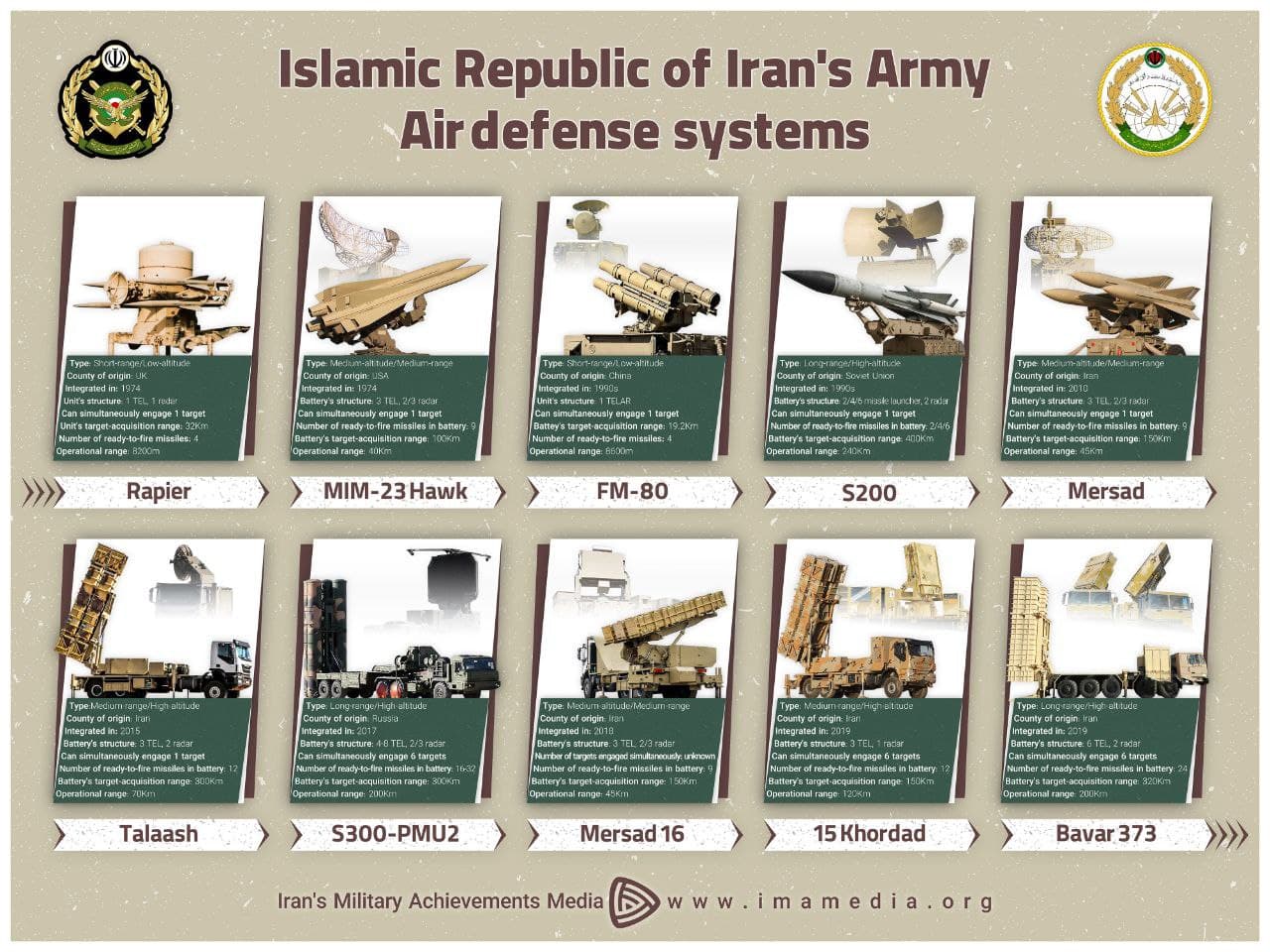
medo and kvs like this post

d_taddei2- Posts : 2967
Points : 3141
Join date : 2013-05-11
Location : Scotland Alba
- Post n°310
 Re: Iran Air Defense Systems
Re: Iran Air Defense Systems
A few systems and pics
3rd of Khordad ''Raad'' TELAR armed with sayyad -2 missiles (upgraded Sa-5) first time Sa-5 been self propelled
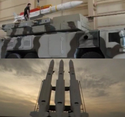
Raad Arash 122mm anti air rocket system. Two types


Sayyad 77mm anti air rocket system few versions, also note this system has also been used as MLRS using different rocket same caliber


Asefeh 23mm Triple barrel battling (could be a good VBIED killer)

Self propelled Mesbah 23mm

35mm Seraj ''Sadegh 10 or Heal

Zu-23-2 on truck with enlarged magazine, and zu-23-2 automatic


Dshk x8 on zpu-4 mount (could be a good VBIED killer)


3rd of Khordad ''Raad'' TELAR armed with sayyad -2 missiles (upgraded Sa-5) first time Sa-5 been self propelled

Raad Arash 122mm anti air rocket system. Two types


Sayyad 77mm anti air rocket system few versions, also note this system has also been used as MLRS using different rocket same caliber


Asefeh 23mm Triple barrel battling (could be a good VBIED killer)

Self propelled Mesbah 23mm

35mm Seraj ''Sadegh 10 or Heal

Zu-23-2 on truck with enlarged magazine, and zu-23-2 automatic


Dshk x8 on zpu-4 mount (could be a good VBIED killer)



ALAMO- Posts : 7075
Points : 7165
Join date : 2014-11-25
- Post n°311
 Re: Iran Air Defense Systems
Re: Iran Air Defense Systems
Looks more like a grandson of SM1 to me
One of the most interesting stuff Iranians have there is a modern version of big calibre AA guns, that is KS19 Saeer and its derivatives.
Operates in batteries, with common targeting, and operates in automatic mode actually.
Imagine the potency of a modern 100mm gun, how deadly ammo can be applied there.
And how fantastic anti-missile and anti-UAV warfare it can unleash for some pennies.

d_taddei2- Posts : 2967
Points : 3141
Join date : 2013-05-11
Location : Scotland Alba
- Post n°312
 Re: Iran Air Defense Systems
Re: Iran Air Defense Systems
ALAMO wrote:
Looks more like a grandson of SM1 to me
One of the most interesting stuff Iranians have there is a modern version of big calibre AA guns, that is KS19 Saeer and its derivatives.
Operates in batteries, with common targeting, and operates in automatic mode actually.
Imagine the potency of a modern 100mm gun, how deadly ammo can be applied there.
And how fantastic anti-missile and anti-UAV warfare it can unleash for some pennies.
Iran did have SM-1 and the issue we have with Iran is they design so many different AD systems and various upgrades and many systems share similar or same names as other systems it's very hard to figure out what's what, they also change the missile shape confusing matters further. I do know that their SM-1 variant has been mounted before.


They have used their version in multiple ways, but I noticed in some versions the range is less than the usual S-200 but also notice the missile being smaller. It's hard to tell as Iran often exaggerate things, and mix n match systems. But the point being is that it is self propelled.
I posted pics etc on sa-ir would be great to see it in action, it's more ideal for higher altitudes but could be useful for drones swarms I always thought a battery of 12 systems, half armed with HE-FRAG with programmable timed fuses and proximity fuses, and the other half armed with EMP rounds, so u have a nice scatter across a large area with a mix of rounds, and the rounds would be fairly cheap.
Also to note that it could be used as a form of artillery, could mount it on a truck for mobility and faster set up times. AA guns during WW2 was also used as artillery and direct role so this system could effectively do three roles, air defence, artillery, direct fire, and having 4 rounds (5 if u pre load) ready to fire self loading could be useful.

George1- Posts : 18400
Points : 18897
Join date : 2011-12-22
Location : Greece
- Post n°313
 Re: Iran Air Defense Systems
Re: Iran Air Defense Systems
Iran's new AD-08 "Majid" air defense system
crod, zepia, starman and Hole like this post

JohninMK- Posts : 15132
Points : 15273
Join date : 2015-06-16
Location : England
- Post n°314
 Re: Iran Air Defense Systems
Re: Iran Air Defense Systems
Aᴍɪʀ
@AmirIGM
·
12 Oct
Stealing the attention at the Defenders of the Velayat skies 1400 exercise today, a potent SHORAD system with:
Phased array search radar
360° coverage with VLS
8 ready to fire missiles
All contained on a cost-effective wheeled vehicle with good mobility
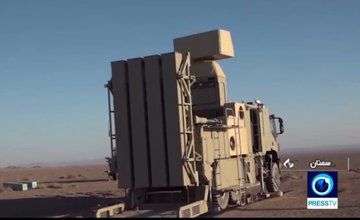
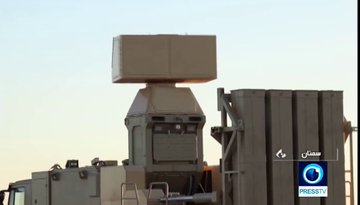
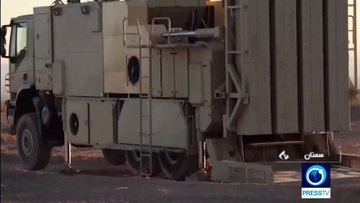
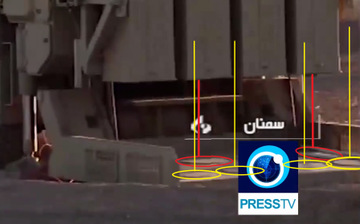
@AmirIGM
·
12 Oct
Stealing the attention at the Defenders of the Velayat skies 1400 exercise today, a potent SHORAD system with:
Phased array search radar
360° coverage with VLS
8 ready to fire missiles
All contained on a cost-effective wheeled vehicle with good mobility




crod and George1 like this post

ALAMO- Posts : 7075
Points : 7165
Join date : 2014-11-25
- Post n°315
 Re: Iran Air Defense Systems
Re: Iran Air Defense Systems
Iranian systems should not be underestimated for several reasons, but one is extremely interesting.
It is its own component base that creates them.
As Iran is targeted by sanctions for 40+ years, they have managed to construct and produce its own electronics, including processors.
And as far as I have read about that, those are vastly unknown to the enemy, making them very much immune to countermeasures.
It is its own component base that creates them.
As Iran is targeted by sanctions for 40+ years, they have managed to construct and produce its own electronics, including processors.
And as far as I have read about that, those are vastly unknown to the enemy, making them very much immune to countermeasures.
GarryB and JohninMK like this post

crod- Posts : 679
Points : 718
Join date : 2009-08-04
- Post n°316
 Re: Iran Air Defense Systems
Re: Iran Air Defense Systems
ALAMO wrote:Iranian systems should not be underestimated for several reasons, but one is extremely interesting.
It is its own component base that creates them.
As Iran is targeted by sanctions for 40+ years, they have managed to construct and produce its own electronics, including processors.
And as far as I have read about that, those are vastly unknown to the enemy, making them very much immune to countermeasures.
I wouldn’t be so sure about the last part of that post. The israelis are well integrated in Iran, we’ve seen time and time again. If they’re able to get shed loads of documents (crates of them) out they can get the circuit boards out just as easily.
The safe/intel houses established during the Shah days have proven irreplaceable to the israelis. From assassinations, theft of documentation and equipment (they are believed to have stolen ventilator machines from them at the beginning of Covid outbreak), launching of software viruses using human action from within the targeted facilities and god knows what else besides - I really doubt they would have any problems at all getting what they need regarding those systems.

Isos- Posts : 11379
Points : 11347
Join date : 2015-11-06
- Post n°317
 Re: Iran Air Defense Systems
Re: Iran Air Defense Systems
GarryB and nomadski like this post

nomadski- Posts : 2903
Points : 2911
Join date : 2017-01-02
- Post n°318
 Re: Iran Air Defense Systems
Re: Iran Air Defense Systems
https://en.mehrnews.com/news/181408/Unknown-drone-crashed-in-central-Iran-VIDEO
Any experts can ID this drone please ? If foreign , then adds to the probability that Natanz object also a Recon drone and not target practice drone as stated by authorities . Makes sense now to put " pressure " on Iran for Nuclear talks . As I suspected the Army hiding possible fact of air incursion by marvellous obstruction by baldy head ! At least this time , it is not a partial eclipse of the sun or thunder cloud ! Iran must absolutely protect important and irreplaceable sites of Atomic things .
Any experts can ID this drone please ? If foreign , then adds to the probability that Natanz object also a Recon drone and not target practice drone as stated by authorities . Makes sense now to put " pressure " on Iran for Nuclear talks . As I suspected the Army hiding possible fact of air incursion by marvellous obstruction by baldy head ! At least this time , it is not a partial eclipse of the sun or thunder cloud ! Iran must absolutely protect important and irreplaceable sites of Atomic things .

GarryB- Posts : 39673
Points : 40169
Join date : 2010-03-30
Location : New Zealand
- Post n°319
 Re: Iran Air Defense Systems
Re: Iran Air Defense Systems
If it crashed due to weather conditions you would think carrying it around on a long line from a helicopter is a pretty daft way of transporting it.
I would take it by helicopter directly to the closest road and then put it on a truck where you could drape a tarp over it and avoid damaging it in the wind.
Regarding the drone itself, a flying wing looks very similar to any other flying wing... engine down the centreline... standard shape for a subsonic aircraft...
The person holding the cell phone should have seen the head in the way and moved to one side... maybe they did and that footage was censored perhaps?
Flying enemy drones to put pressure on Iran would not make a lot of sense... Iran could send up some F-5s to use their 20mm cannon to bring such a large target down very easily... even MANPADS modified to be carried on light fighters in packs of four missiles per pylon would be a cheap simple way of dealing with such things... in fact even a helicopter could be used depending on the flight speed and altitude of the drone.
Conversely it could be an Iranian drone that is flying around looking for enemy activity in the air or on the ground in restricted areas... a drone with thermals can observe an enormous area of empty ground at once and would be ideal for spotting people in places where they should not be.
I would suspect the latter as being most likely because if it is the former it would make rather more sense to release official footage and make public statements and turn the pressure onto those launching the drones.... in the form of... if you had the deal back in place you would be allowed inspectors on the ground whom we would not shoot down and take into custody.
I would take it by helicopter directly to the closest road and then put it on a truck where you could drape a tarp over it and avoid damaging it in the wind.
Regarding the drone itself, a flying wing looks very similar to any other flying wing... engine down the centreline... standard shape for a subsonic aircraft...
The person holding the cell phone should have seen the head in the way and moved to one side... maybe they did and that footage was censored perhaps?
Flying enemy drones to put pressure on Iran would not make a lot of sense... Iran could send up some F-5s to use their 20mm cannon to bring such a large target down very easily... even MANPADS modified to be carried on light fighters in packs of four missiles per pylon would be a cheap simple way of dealing with such things... in fact even a helicopter could be used depending on the flight speed and altitude of the drone.
Conversely it could be an Iranian drone that is flying around looking for enemy activity in the air or on the ground in restricted areas... a drone with thermals can observe an enormous area of empty ground at once and would be ideal for spotting people in places where they should not be.
I would suspect the latter as being most likely because if it is the former it would make rather more sense to release official footage and make public statements and turn the pressure onto those launching the drones.... in the form of... if you had the deal back in place you would be allowed inspectors on the ground whom we would not shoot down and take into custody.

Mig-31BM2 Super Irbis-E- Posts : 730
Points : 746
Join date : 2016-01-20
- Post n°320
 Re: Iran Air Defense Systems
Re: Iran Air Defense Systems
Maybe an Iranian copy which Natanz has tested?

ALAMO- Posts : 7075
Points : 7165
Join date : 2014-11-25
- Post n°321
 Re: Iran Air Defense Systems
Re: Iran Air Defense Systems
As they wrote in the news, it can be either Shahed 171, or RQ-170.

Mig-31BM2 Super Irbis-E- Posts : 730
Points : 746
Join date : 2016-01-20
- Post n°322
 Re: Iran Air Defense Systems
Re: Iran Air Defense Systems
Irans Dezful SAM system, 15 years after receiving Tor-M1
Basic layout of Tor-M1 was probably retained to support the existing fleet with identical spare parts.
Automatic GNSS system and compass reduces risk of events like the airliner downing of 2020, but no IFF yet.
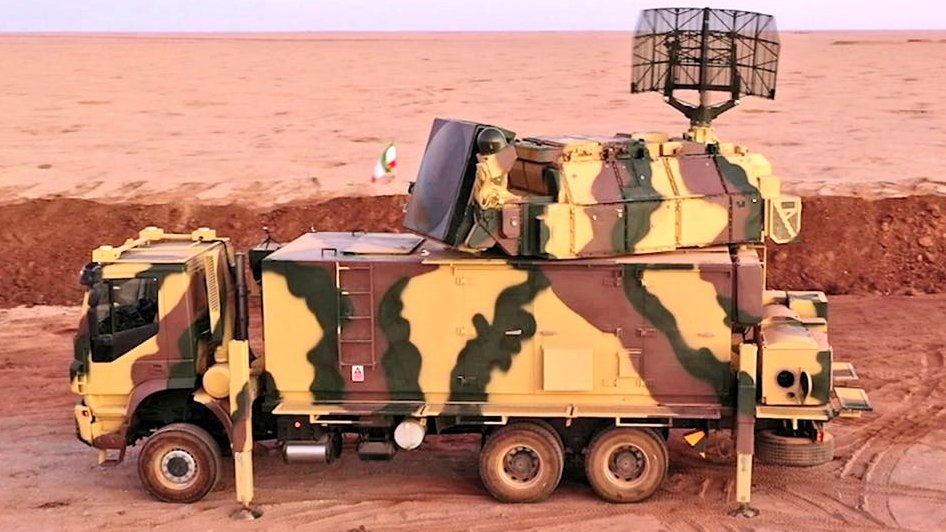
Is this an Iranian copy of TorM1?
Does Iran have a production line for 9k331?
Basic layout of Tor-M1 was probably retained to support the existing fleet with identical spare parts.
Automatic GNSS system and compass reduces risk of events like the airliner downing of 2020, but no IFF yet.

Is this an Iranian copy of TorM1?
Does Iran have a production line for 9k331?

GarryB- Posts : 39673
Points : 40169
Join date : 2010-03-30
Location : New Zealand
- Post n°323
 Re: Iran Air Defense Systems
Re: Iran Air Defense Systems
the Iranian engineers are very talented and have proven themselves time and again, but I suspect Russia would have assisted in the development of this vehicle.... the original TOR vehicle was tracked and intended to move cross country with armoured formations, but being a tracked vehicle it was slow and noisy and expensive to buy and expensive to operate.
A wheeled model can move at motorway speeds for long periods with low vibration, is much cheaper to buy and cheaper to operate and maintain.
the turret portion is for the air defence vehicle but the rest is just mobility and propulsion so it is like designing a truck, which I am sure Iran could manage on their own really... but the makers of the TOR system have already shown several wheeled models to make them more affordable.
Like most SAMs of this type having them in large numbers makes them more effective and useful.
The missiles are cheap command guided weapons so missile numbers are not a problem, and using missiles is not horrendously expensive either.
A wheeled model can move at motorway speeds for long periods with low vibration, is much cheaper to buy and cheaper to operate and maintain.
the turret portion is for the air defence vehicle but the rest is just mobility and propulsion so it is like designing a truck, which I am sure Iran could manage on their own really... but the makers of the TOR system have already shown several wheeled models to make them more affordable.
Like most SAMs of this type having them in large numbers makes them more effective and useful.
The missiles are cheap command guided weapons so missile numbers are not a problem, and using missiles is not horrendously expensive either.

Isos- Posts : 11379
Points : 11347
Join date : 2015-11-06
- Post n°324
 Re: Iran Air Defense Systems
Re: Iran Air Defense Systems
Who knows what sails between the two countries through Caspian sea. No one can spy on them there.
GarryB and ALAMO like this post

Mig-31BM2 Super Irbis-E- Posts : 730
Points : 746
Join date : 2016-01-20
- Post n°325
 Re: Iran Air Defense Systems
Re: Iran Air Defense Systems
and what?Isos wrote:Who knows what sails between the two countries through Caspian sea. No one can spy on them there.





